|
PROJECTS
     
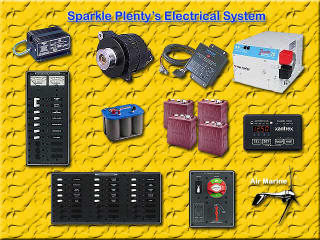 Here are the components to the refurbished electrical
system. During the Winter of 2002-03, I began a major electrical
renovation and upgrade. My goal was to bring the system up to ABYA
standards. SP is setup for extensive cruising, but like all older vessels,
the electrical system is layered with old wiring and many original
components are ready for replacement. (Click pictures for
a larger view.)
The upgrades
I settled on
included a new Newmar galvanic isolator; new Blue Sea AC and
DC panels (the
original Mariner panel was combined); a new Freedom Marine 2500 watt
inverter/charger; a new Xantrex LINK 1000 inverter controller/battery monitor;
and a new
Blue Sea battery switch with house bank, starting, and combiner switches.
The system already includes a a recent Leece-Neville 95 amp alternator; a
Heart
Interface In-Charge regulator; an Air Marine wind generator; a
high cranking starter battery; and four 6 volt Trojan golf cart
batteries for the house bank.
|
Spring 2003: the new electrical installation is 95% complete.
|
Here
is the new 120 volts BlueSea AC panel (8074) and Xantrex Link 1000.
The AC panel has:
- One double-pole 30 Amp AC main circuit breaker
- Five 15 Amp circuit breakers
- Three blank positions
- 0-50 Ampere ammeter with remote sensing coil
- 0-150 Volt AC Voltimeter
- Label Backlight System
|
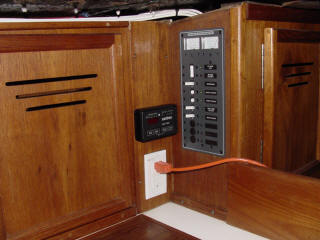 |
| The Link 1000 provides complete remote control for the
Freedom Marine
2500 watt inverter/130 Amp charger. It also provides extensive monitoring functions
for the battery system. |
Here is the new Blue Sea DC panel (8264). It features:
- 24 circuit breaker positions
- Fifteen 15 Amp breakers installed
- All positive, negative and grounding buses installed, fully
pre-wired
- Label Backlight System -- This is a great help at night. The
top left switch turns on the backlighting as well as red
courtesy lights throughout the saloon.
|
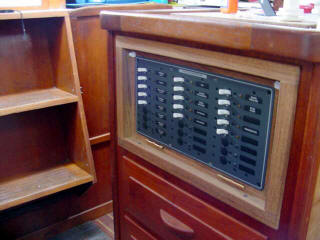 |
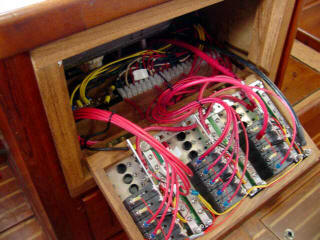 |
All wiring was run to a buss behind the panel including older
wires from cabin lights as well as new DC wiring. Spare buss
positions allow easy wiring of new circuit breakers as needed. |
| An Incharge Heart Interface regulator had come
with the boat but was not hooked up since the existing alternator
had its own built in regulator. We detached the built in regulator
and wired in the Heart (remounted above icebox next to steps)
to give us smart charging under power. This worked for a while, but
the regulator just wasn't up to it and burned up. |
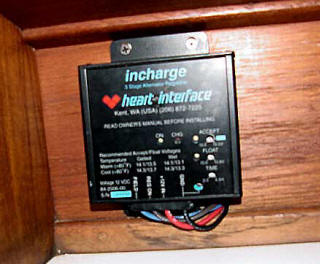
|
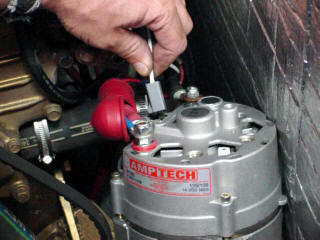 |
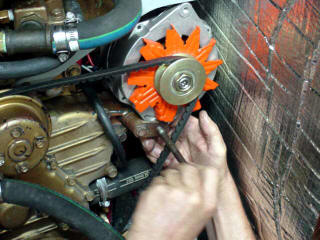 |
| So I replaced the old unit with a high output "S"
series AMPTECH 125 amp alternator designed to work with the
Heart Interface regulator. This model is able to deliver high output
on a single standard engine belt and pulley. It's specifically made
to charge deep-cycle house battery banks. |
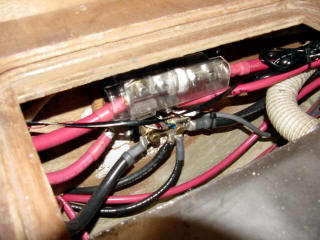
Fuses, battery cables and inverter wiring leading into
house battery box.
| Winter 2004: we upgrade the propane control panel.
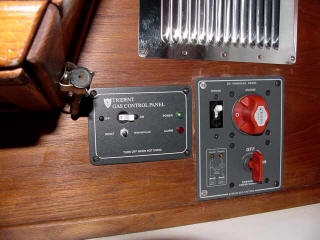 The Trident Gas Control Panel
next to the Blue Sea Battery Combo Switch installed earlier.
I really like this switch. It isolates the house and starter banks.
You don't have to worry about switching to A or B. Just turn on your
house (toggle switch upper left) and when your ready to start the
diesel, turn on the engine switch (knob switch upper right). If your
starting battery runs low, turn on the combiner (key switch bottom
right) to access both starter and house banks to start the engine.
The LED schematic (lower left) shows which switches are on. The
Trident Gas Control Panel turns the propane solenoid on and off. It
also has a built in circuit breaker and sniffer alarm. See
Propane System Project for
more details. The Trident Gas Control Panel
next to the Blue Sea Battery Combo Switch installed earlier.
I really like this switch. It isolates the house and starter banks.
You don't have to worry about switching to A or B. Just turn on your
house (toggle switch upper left) and when your ready to start the
diesel, turn on the engine switch (knob switch upper right). If your
starting battery runs low, turn on the combiner (key switch bottom
right) to access both starter and house banks to start the engine.
The LED schematic (lower left) shows which switches are on. The
Trident Gas Control Panel turns the propane solenoid on and off. It
also has a built in circuit breaker and sniffer alarm. See
Propane System Project for
more details. |
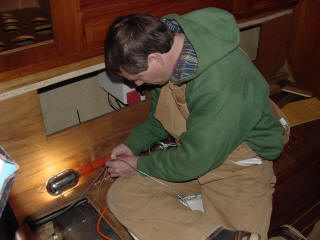 Marine
electrician, Andy Fegley (Yacht Electronic Systems) works on rewiring. I
worked as his gofer and tried to learn as much as I could. Note the
inverter mounted in the storage bin behind the port settee. We bolted
the unit to the bulkhead separating the two bins. Marine
electrician, Andy Fegley (Yacht Electronic Systems) works on rewiring. I
worked as his gofer and tried to learn as much as I could. Note the
inverter mounted in the storage bin behind the port settee. We bolted
the unit to the bulkhead separating the two bins.
DC PANEL & INVERTER PICTURES WILL GO HERE.
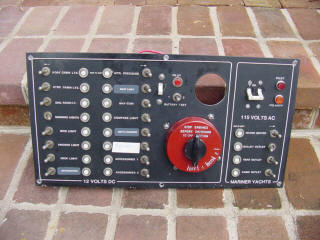 |
The original Mariner DC/AC panel with 3-position
battery switch. |
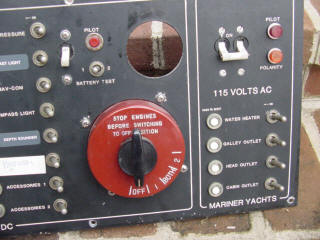 |
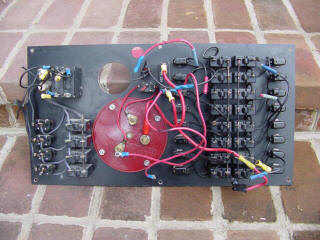 |
|